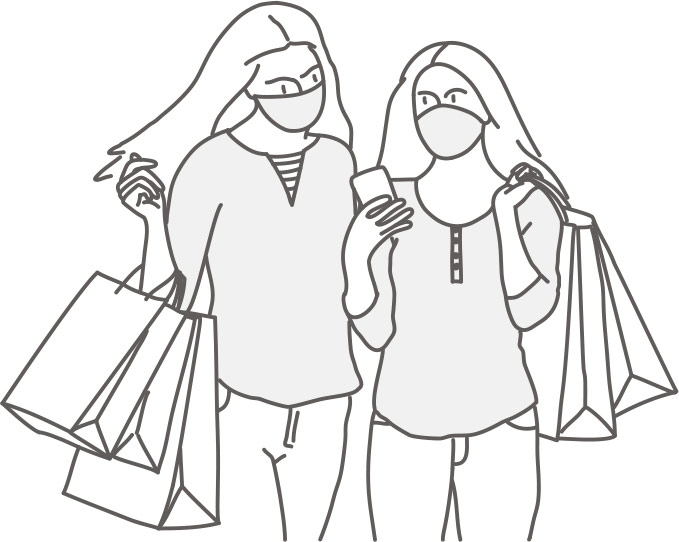 With the prospect of the pandemic continuing for the foreseeable future, many retailers are searching for clues on how to act most effectively. It doesn’t help that when you have a physical store, you’re subjected to unrelenting stories like how department stores are dinosaurs, small businesses are closing and online business is our future. However, while those kinds of doom-and-gloom articles may get clicks, online selling is not the magic pill it is billed as to combat COVID-19 challenges.
With the prospect of the pandemic continuing for the foreseeable future, many retailers are searching for clues on how to act most effectively. It doesn’t help that when you have a physical store, you’re subjected to unrelenting stories like how department stores are dinosaurs, small businesses are closing and online business is our future. However, while those kinds of doom-and-gloom articles may get clicks, online selling is not the magic pill it is billed as to combat COVID-19 challenges.
Besides the 30-40 percent return rate, expensive shipping costs and fleeting loyalty, there’s new evidence customer expectations are not being met. Thomas Robertson, professor of marketing at The Wharton School of the University of Pennsylvania, reports 66 percent of consumers complained about at least one issue on their last online shopping trip this last quarter, up from only 10 percent in the first three months of the year. Chief among the complaints were having to purchase an item online and pay shipping to return it, difficulties navigating websites and apps, not being able to return items without the original receipt and only being able to purchase the item they wanted online instead of at a nearby store.
Robertson issued a caution to retailers regarding customers who participate in loyalty programs based on shopping online. “Members of loyalty programs tend to have higher expectations and therefore experience more problems than that of non-members,” he says. “We believe that this is because members typically are more engaged and have higher customer lifetime value than non-loyalty members. Losing loyalty program members may lead to long-term degradation to the brand and may have significant financial impact to the retailer.”
Keeping that in mind, there are still several new and inventive ways to deal with the COVID-19 pandemic through your physical store. Here’s some ideas to get you started.
Implementing QR codes
Jonny Cota, the winner of Amazon’s “Making the Cut,” has visitors scanning a QR code upon entering his new store in Los Angeles. It launches a friendly welcome video by Cota, which tells shoppers about the brand and COVID-19 rules. He also lets customers shop a gallery-like space via a virtual tour or in real life, using their phones and QR codes as a guide to scan styles, see them on models and add them to a digital cart that can be shipped or fulfilled in-store.
Adding in-house contact tracing
Every retailers’ nightmare is having to close due to someone testing positive for COVID-19. In a recent Coresight webinar, Tractor Supply’s Glenn Allison spoke about how they are providing contact tracing for the company’s 1,700 stores, distribution centers and support centers. They want to quickly know who someone came in contact with, so they can pick up where government has left off.
Removing doubt
One of the problems with curbside and BOPIS is finding ways for the consumer to know what to do. Target has easy-to-follow instructions that are everywhere, including how to download their app right on their sign.
Curtailing orders
Shoppers will be frustrated with out-of-stocks this holiday season; you can bet on it. But retailers don’t want to have to keep the discounts they’ve been using to unload spring merchandise, to continue into the holidays. Levi Strauss & Co. CEO and president Chip Bergh says, “I would actually rather leave a sale on the table—miss a sale—because we don’t have product, than to have a glut of product that you then would have to mark down.”
Building community on the sidewalk
With CDC guidance on limited occupancy, many retailers are having to make shoppers wait at 6-foot intervals by using stickers on the sidewalk. According to Dave Bruno on the Aptos blog, London’s Notting Hill Fish Shop has set up folding chairs to let people sit and socialize while waiting in line. “Shoppers have taken to the idea and fallen in love with the ability to socialize while social distancing.”
Hiring influencers
In an effort to convince more shoppers to enter its stores, Nordstrom has debuted an influencer campaign that promotes its in-store coronavirus safety precautions. The department store giant recently hired Instagram influencers to visit and take photos inside its New York flagship store. Wendy Nguyen, one fashion influencer, told followers that visiting Nordstrom was refreshing because “everyone was wearing masks, practicing social distancing and were incredibly kind. Even shoppers, strangers as we were, stopped and had meaningful conversations.”
Expanding markets
Katz’s Delicatessen in New York was featured in a recent Business Insider video sharing how they looked to their heritage and expanded their markets during the crisis from just one local New York icon to reach direct-to-consumers across the country. The options to reach new markets has never been easier to scale. Stores are also pivoting to get associates to text and email their local customers about new products and services.
 Bob Phibbs, a.k.a. The Retail Doctor, is an internationally recognized business strategist, customer service expert, sales coach, marketing mentor, author of three books, and motivational business speaker. He is a Top Voice on LinkedIn with 400k followers. His popular online retail sales training program SalesRX is leading double-digit increases for his clients. For more information, visit retaildoc.com.
Bob Phibbs, a.k.a. The Retail Doctor, is an internationally recognized business strategist, customer service expert, sales coach, marketing mentor, author of three books, and motivational business speaker. He is a Top Voice on LinkedIn with 400k followers. His popular online retail sales training program SalesRX is leading double-digit increases for his clients. For more information, visit retaildoc.com.



Leave a Comment: